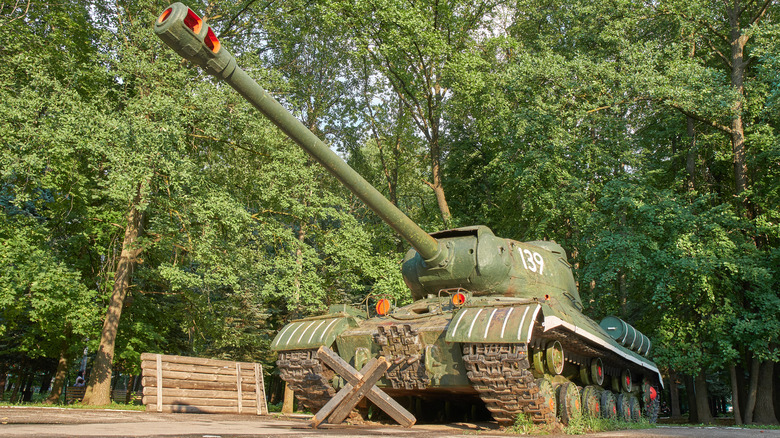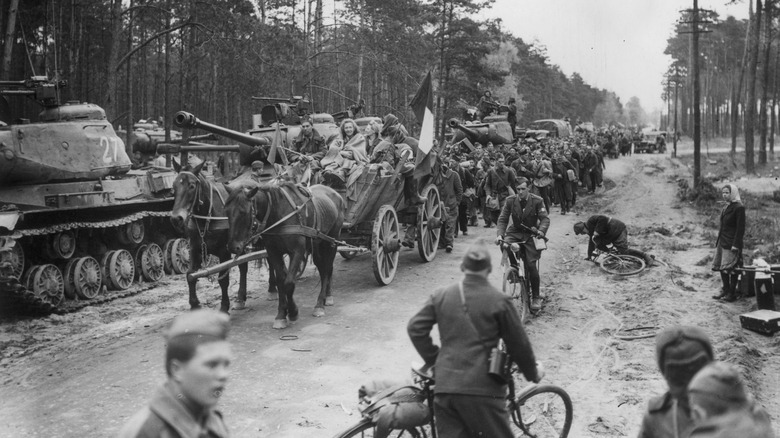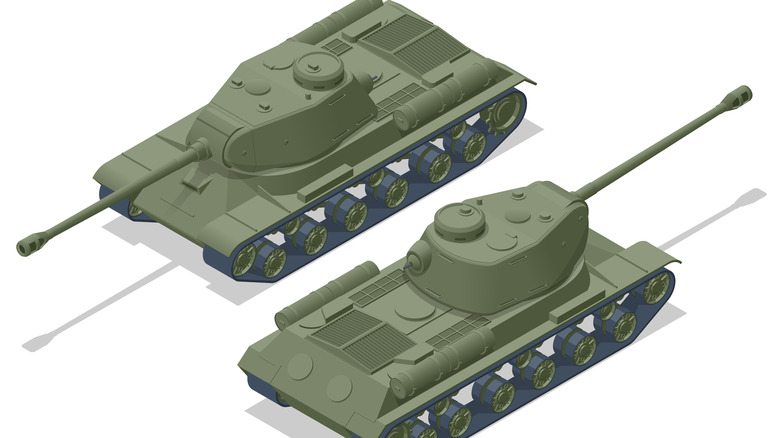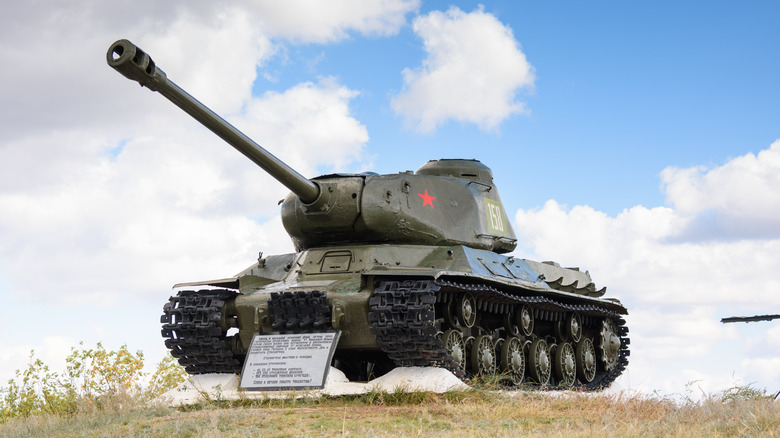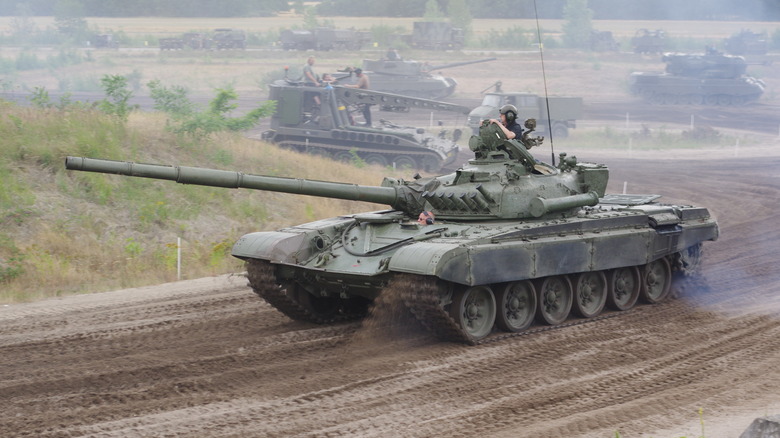Why The IS-2 Heavy Tank Was So Important For The Soviet Union
Originally produced eight decades ago, the impact of the IS-2 Heavy Tank still reverberates today. The formidable armored vehicle was vital to the Soviet Union during two of its most important conflicts: World War II and the Cold War. Its importance to Soviet history is fitting, since it's named after one of the nation's most influential rulers: Josef Stalin. (The "IS" stands for "Iosef Stalin," an alternate spelling to the General Secretary's name.)
Stalin was leader of the Soviet Union during World War II, when the IS-2 was first developed to help defeat German forces at a time when it wasn't certain that was possible. After being introduced toward the end of the war, the IS-2 became the first armored unit to open fire on Reichstag, ultimately helping Russian forces march into the heart of Nazi Germany and defeat their once-invaders. The victory in Berlin ultimately helped the Soviet Union become one of two superpowers for most of the rest of the 20th century. Later, as the U.S. and the U.S.S.R. competed in an arms race that dwarfed any before it, the IS-2 also played a role in the U.S.S.R maintaining regional dominance on the eastern side of the Iron Curtain before its eventual dissolution in 1991.
Just as some tanks represent the strength of the armed forces of their respective nations — such as the American M1 Abrams and Germany's Leopard 2 battle tank — the IS-2 has come to symbolize the historical resourcefulness and might of the Soviet Union.
The IS-2 gave Soviet forces greater range
The IS-2 was developed during the last few years of World War II. It went by the name Object 240, as per the Soviet system of naming military prototypes (such as Object 279, the unique Soviet tank that was too heavy to build). It was the successor to the IS-1, which was a modernized version of the KV-1 tank. By 1942, mechanical issues of the KV-1 tank had come to light, and several prototypes were made as potential successors. The IS-1 was eventually selected and quickly replaced by the IS-2, which was developed in 1943.
The IS-2 was armed with a 122 mm D-25T cannon, significantly more powerful than the 85 mm gun found on the IS-1 tank. With this large gun, the IS-2 could take out German tanks such as the Tiger from a long distance. This allowed Soviet troops to advance their front lines through cities and other rough terrain. It also helped the Russians fight their way into German terrain after years of being on the defensive. With Germany battling significant Soviet forces on its Eastern Front, as well as the advancing Allied armies on its Western Front, the Nazis' days had become numbered.
Reportedly, Stalin knew the IS-2 was a key to victory after examining the new armored vehicle, saying, "With this tank, we will finish the war." So, the IS-2 was quickly rushed into production in early 1944.
The IS-2 was formidable in battle
The heart of the IS-2 was its 12-cylinder V2 engine, which was mounted in a rear compartment within its hull and generated 600 horsepower. This enabled the heavy tank to reach 23 miles per hour with a range of 149 miles. This is even more impressive when considering the vehicle's weight: 112,436 pounds (56.2 tons).
Additional fuel could be carried (at some risk) along the rear sides of the tank's hull for extended range. The IS-2 was 32.5 feet long, 10.1 feet wide, and 9 feet tall, with enough space for a four-person crew. It had four guns: two machine guns that could fire 7.62 mm rounds, a DShK heavy machine gun in a coaxial mount that fired 12.7 mm rounds, and, most importantly, its D25-T main gun, which could fire 122 mm rounds. A standard IS-2 was stocked with 28 of these massive explosive rounds, as well as 250 rounds of 12.7 mm and 2,520 7.62 mm ammunition. With one machine gun facing the rear to fend off enemy infantry and the 12.7 mm gun included to defend against aircraft, the IS-2 was a formidable addition to Soviet front lines.
The Soviet Union strengthened itself by supplying its allies with the IS-2
Several nations (mostly Soviet allies) deployed the IS-2, either during World War II or after when the Cold War dominated global politics. By supplying the Eastern Bloc with the formidable IS-2, the Soviet Union was able to establish and maintain dominance in continental Europe and keep a significant buffer between itself and the West. After it became an ally of the Soviet Union, for example, Hungary's army deployed 68 IS-2 tanks between 1950 and 1956. Other European nations that used the tank during this time were Romania, Poland, Czechoslovakia, and East Germany.
During the height of the Cold War, the U.S.S.R also supplied enemies of the U.S. with the IS-2, which helped the nation compete with the world's other major superpower. It delivered 41 variants of the IS-2 to Cuba in 1960, shortly before America's failed Bay of Pigs invasion. The Soviet Union also delivered 60 IS-2s to China in 1950 and 1951 to fight in the Korean War, which was a proxy war between the Soviets and the U.S. IS-2 tanks were also delivered to North Korea, where some remain active even to this day.
By supplying both its allies and enemies of its enemy with the IS-2, the Soviet Union made itself stronger while also diverting American resources. Likewise, it stands to reason that the more countries became dependent on the Soviet Union, the less likely they would be to switch allegiances to the West.
The IS-2 paved the way for the main battle tank's dominance in the Cold War and beyond
An arms race with the U.S. and the West meant that the IS-2 needed to be constantly evolving and, eventually, replaced. Its direct follow-up was the IS-3, which was developed too late to see action in World War II. However, it was deployed in the Hungarian Revolution, Prague Spring, and the Six-Day War. Five other IS tank iterations were produced. Ultimately the final model, the IS-8, was renamed the T-10 after Stalin died. His death also coincided with Cold War generals coming to favor the main battle tank design instead, which combined the firepower and armor of a heavy tank with the mobility of a light tank.
Eventually, the Soviets were able to perfect one of the most impressive tanks of all time, the T-72, which rolled off the assembly line in 1973 and has since become the most widely used main battle tank in the world. Over 35 nations have deployed the T-72, which has seen action in many conflicts since the 1980s and helped keep the Soviet Union a superpower before its eventual collapse.
Russia continues to use it to this day, where it has faced off against the Leopard 2 and M1 Abrams in the current Russo-Ukrainian War. Despite being over 50 years old, Russia is still counting on the effectiveness of the T-72, just as the Soviet Union once counted on the IS-2 during prior conflicts.
